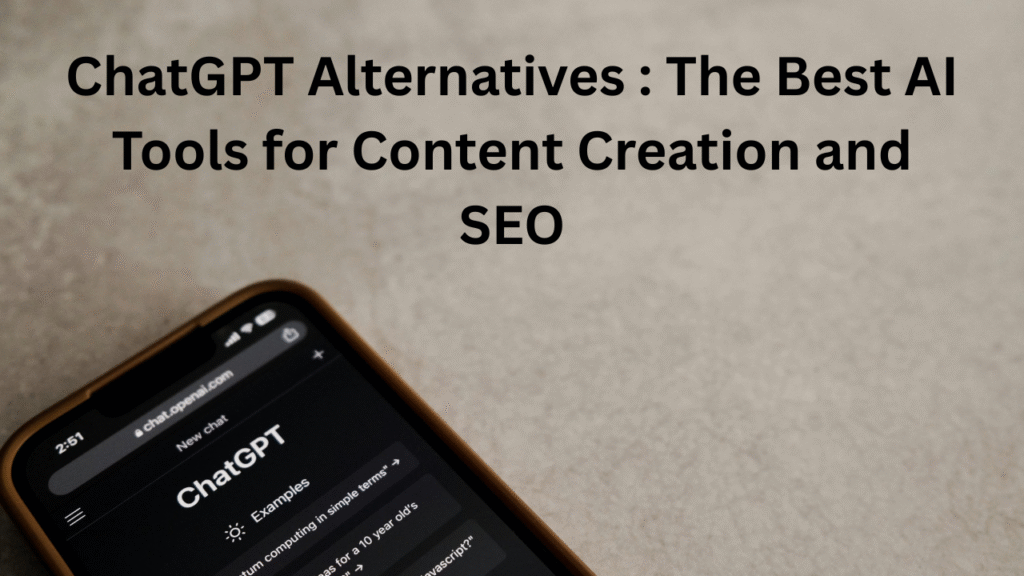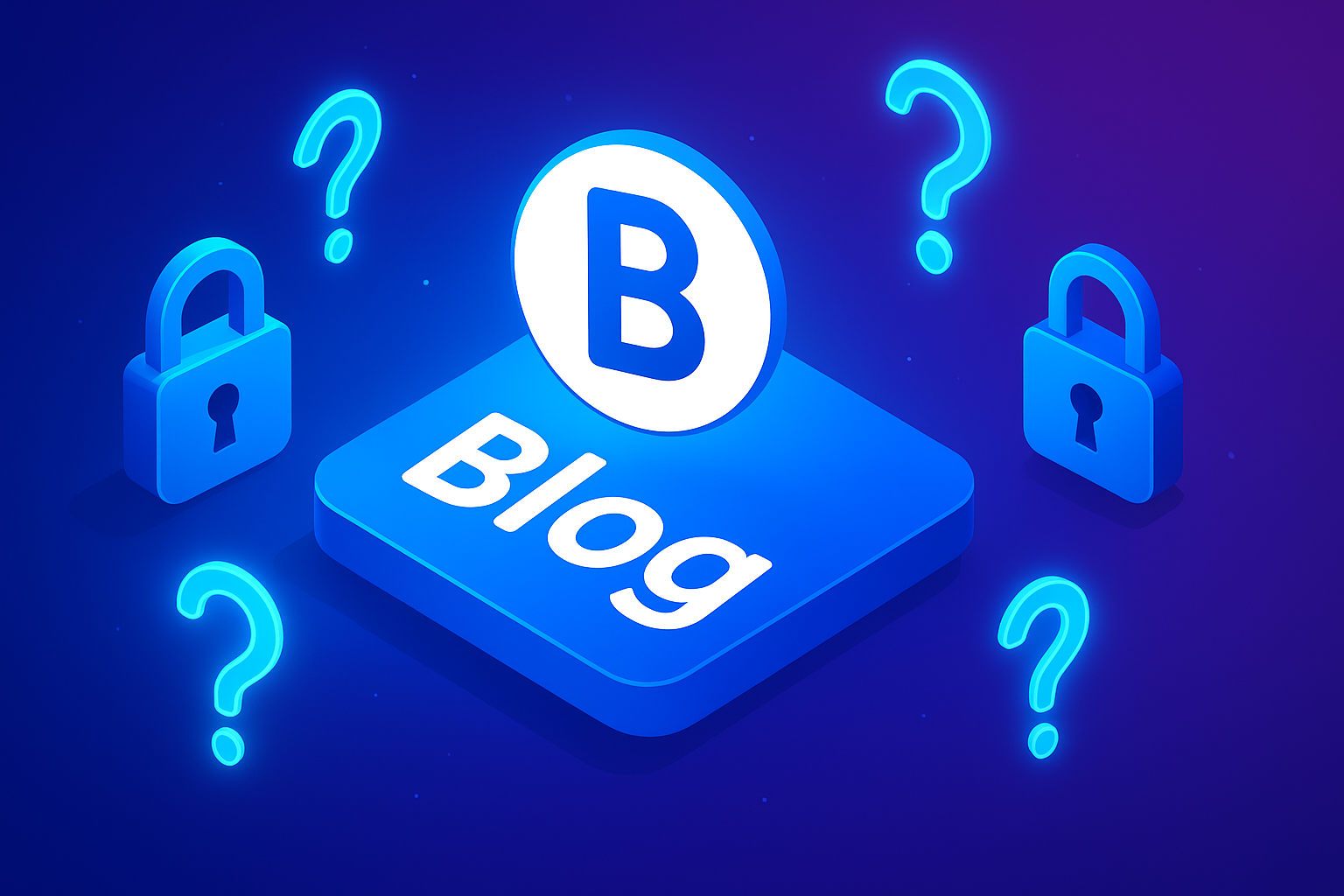ChatGPT, developed by OpenAI, revolutionized AI content creation with its human-like text generation, but its limitations—such as word count caps, outdated data, and lack of real-time web access—have driven content creators, digital marketers, and businesses to seek ChatGPT alternatives in 2025. With over 7.5 million blog posts published daily (Narrato), standing out requires AI tools that offer advanced features like real-time data, SEO optimization, and content automation.
This Blog guide reviews the best ChatGPT alternatives for blogging, SEO workflows, and productivity, drawing on insights from SurferSEO, Hostinger, and Backlinko. Optimized for SEO, it incorporates keyword research strategies (per your July 28, 2025 interest) to help you choose the best AI tool for your needs.
Why Look for ChatGPT Alternatives in 2025?
ChatGPT excels at generating conversational text, but its constraints make ChatGPT alternatives appealing:
- Word Count Limits: ChatGPT caps outputs at ~500 words, requiring multiple prompts for long-form content .
- Outdated Data: Lacks real-time web access without plugins.
- Plagiarism Risks: AI-generated content may require humanization to pass AI detectors .
- SEO Limitations: Inaccurate keyword data compared to tools like SEMrush or Ahrefs .
- Specialized Needs: Businesses need AI tools with SEO integrations, image generation, or custom workflows .
ChatGPT alternatives offer real-time SERP data, SEO-optimized content, and automation to streamline content marketing. This guide explores 10 AI tools that outperform ChatGPT for specific use cases in 2025.
Tip: Target long-tail keywords like best ChatGPT alternatives for SEO 2025 to boost SERP rankings.
Top 10 ChatGPT Alternatives for 2025
Here’s a detailed review of the best ChatGPT alternatives for content creation, SEO, and productivity, with features, pricing, pros, cons, and use cases.
1. Grok (xAI)
Grok, created by xAI, is a conversational AI chatbot designed to provide truthful, concise answers and assist with content creation and SEO tasks. It’s accessible on grok.com, x.com, and mobile apps with a free tier and higher quotas via SuperGrok subscriptions.
- Key Features:
- Real-time web access for up-to-date answers (xAI).
- Think Mode for deeper analysis and DeepSearch Mode for iterative web searches (activated via UI buttons).
- Voice mode on iOS/Android apps for hands-free use.
- SEO content generation with keyword optimization and blog outlines.
- Pricing: Free tier with limited quotas; SuperGrok pricing at x.ai/grok.
- Pros:
- Free access with robust features (xAI).
- SEO-friendly outputs for bloggers and marketers.
- Integrates with X platform for social media content.
- Cons:
- BigBrain mode not publicly available (xAI).
- Limited keyword research compared to SEMrush .
- Best For: Bloggers and content creators needing free, versatile AI tools for SEO content.
- Example: Generate a 1500-word SEO-optimized blog post on vegan recipes with Grok’s DeepSearch Mode to pull trending keywords.
Tip: Use Grok for AI blogging tools to create keyword-rich content.
2. Chatsonic (Writesonic)
Chatsonic is an advanced ChatGPT alternative with real-time Google Search integration, custom brand voice, and SEO automation (Writesonic).
- Key Features:
- Pulls live SERP data for accurate keyword research (Writesonic).
- AI Content Genie generates weekly SEO-optimized articles
- Integrates with Ahrefs and WordPress for streamlined workflows.
- AI image generator for blog visuals
- Pricing: Free plan; Premium starts at $12/month (Writesonic).
- Pros:
- Real-time data outperforms ChatGPT’s static knowledge (Writesonic).
- SEO-optimized content with NLP keywords .
- Custom brand voice settings for consistent content marketing.
- Cons:
- Higher-tier plans needed for advanced features (Writesonic).
- Learning curve for prompt engineering
- Best For: Digital marketers and agencies needing SEO automation and content creation.
- Example: Use Chatsonic to generate meta descriptions under 160 characters for eCommerce blogs.
Tip: Target Chatsonic for SEO to attract content marketers.
3. Surfer AI (SurferSEO)
Surfer AI specializes in long-form content creation, generating 3000+ word articles in ~20 minutes without multiple prompts (SurferSEO).
- Key Features:
- Analyzes top-ranking pages for keyword optimization (SurferSEO).
- Humanizer ensures content passes AI detectors (SurferSEO).
- Includes related keywords and optimal word counts for SERP rankings.
- Pricing: Starts at $29/month (SurferSEO).
- Pros:
- No word count limits, unlike ChatGPT (SurferSEO).
- SEO-optimized articles based on competitor analysis.
- Fast content generation for bloggers.
- Cons:
- Higher cost than ChatGPT’s free tier (SurferSEO).
- Limited to content creation without conversational features
- Best For: Bloggers and SEO professionals creating long-form content.
- Example: Generate a 3100-word SEO blog on healthy recipes with Surfer AI’s keyword analysis.
Tip: Use Surfer AI for long-form SEO content to rank for blogging keywords.
4. Gemini (Google)
Gemini, Google’s AI chatbot, integrates with Google’s ecosystem for content drafts and research (SurferSEO).
- Key Features:
- Multiple draft responses for refined outputs
- Google Search integration for real-time data.
- SEO-friendly content with schema markup support
- Pricing: Free with Google account; premium features via Google One
- Pros:
- Seamless Google ecosystem integration
- Free access for basic content creation.
- Strong NLP processing for human-like text.
- Cons:
- Less versatile than ChatGPT for non-SEO tasks
- Limited keyword research depth
- Best For: Google users needing content drafts and SEO insights.
- Example: Use Gemini to draft blog intros for small business SEO.
Tip: Optimize for Gemini AI for blogging to target Google users.
5. Claude (Anthropic)
Claude, developed by Anthropic, emphasizes safety and human-like text for content creation
- Key Features:
- Generates plagiarism-free content with a focus on ethical AI
- Conversational tone for blog posts and social media.
- Prompt engineering for SEO-friendly outlines
- Pricing: Free tier; Pro at $20/month (Anthropic).
- Pros:
- Strong focus on content quality and ethics
- SEO-friendly outputs with minimal editing
- Cons:
- No real-time web access
- Limited SEO integrations compared to Chatsonic
- Best For: Content creators prioritizing ethical AI and blogging.
- Example: Use Claude to write FAQ sections for recipe blogs.
Tip: Target Claude for content creation to attract ethical AI users.
6. Perplexity AI
Perplexity AI is a conversational search engine with real-time web access for research and content generation (Pipeline Velocity).
- Key Features:
- Answers long-tail questions with web citations
- SEO content generation with keyword clustering
- Generative Engine Optimization (GEO) for AI search visibility
- Pricing: Free; Pro at $20/month
- Pros:
- Real-time data for accurate SEO research
- GEO optimization for ChatGPT-like engines
- Cons:
- Less focus on long-form content than Surfer AI
- Limited image generation
- Best For: SEO professionals needing research tools and GEO optimization.
- Example: Use Perplexity to analyze People Also Ask questions for blog topics.
Tip: Optimize for Perplexity AI for SEO to target research-focused users.
7. Jasper AI
Jasper AI is tailored for marketing teams and content creators, offering SEO-optimized content and brand voice customization (Narrato).
- Key Features:
- Blog post generator with keyword integration
- Team collaboration tools for content workflows.
- AI image generation for blog visuals.
- Pricing: Starts at $39/month .
- Pros:
- SEO-friendly outputs with brand consistency
- Fast content creation for marketing campaigns
- Cons:
- Higher cost than ChatGPT’s free tier
- Limited technical SEO features
- Best For: Marketing teams needing SEO content and visuals.
- Example: Use Jasper to create social media posts for recipe blogs.
Tip: Target Jasper AI for marketing to attract content teams.
8. Copy.ai
Copy.ai focuses on short-form content like ad copy, meta descriptions, and social media posts (Writesonic).
- Key Features:
- SEO-optimized meta tags and ad copy
- Workflow automation for content marketing
- Brand voice templates for consistent copywriting.
- Pricing: Free tier; Pro at $36/month
- Pros:
- Fast short-form content generation
- Affordable for small businesses
- Cons:
- Limited long-form content capabilities
- Basic SEO features compared to SEMrush
- Best For: Small businesses needing ad copy and meta descriptions.
- Example: Generate SEO meta descriptions for eCommerce product pages.
Tip: Use Copy.ai for SEO copywriting to target small business owners.
9. Rytr
Rytr is a budget-friendly AI writing tool for bloggers and freelancers
- Key Features:
- SEO-optimized blog posts with keyword integration
- Plagiarism checker for original content
- 40+ use cases for content creation
- Pricing: Free plan; Premium at $9/month
- Pros:
- Affordable for blogging beginners
- Simple interface for content creation
- Cons:
- Limited real-time data access
- Basic SEO tools compared to Surfer AI
- Best For: Freelancers and bloggers on a budget.
- Example: Use Rytr to draft blog outlines for travel blogs.
Tip: Optimize for Rytr for blogging to attract budget-conscious creators.
10. StoryChief
StoryChief combines content creation with SEO optimization and content distribution (StoryChief).
- Key Features:
- SEO content outlines with keyword research (StoryChief).
- Content calendar for blog scheduling.
- Social media integration for content distribution (StoryChief).
- Pricing: Starts at $40/month (StoryChief).
- Pros:
- All-in-one content marketing platform (StoryChief).
- SEO-friendly outputs with keyword suggestions
- Cons:
- Higher cost than Rytr
- Limited AI image generation
- Best For: Agencies managing content workflows.
- Example: Use StoryChief to create SEO content plans for healthcare blogs.
Tip: Target StoryChief for content marketing to attract agencies.
How to Choose the Best ChatGPT Alternative
Selecting the right ChatGPT alternative depends on your goals, budget, and use case. Consider these factors:
- Purpose: Need long-form content (Surfer AI), SEO research (Perplexity), or ad copy (Copy.ai)? (SurferSEO).
- Budget: Free options like Grok or Gemini vs. premium tools like Jasper ($39/month)
- SEO Features: Prioritize real-time data (Chatsonic) or competitor analysis (Surfer AI)
- Ease of Use: Rytr for beginners; Chatsonic for advanced users
- Integrations: Tools like Chatsonic integrate with Ahrefs and WordPress
Example: A cooking blogger (per your previous requests) might choose Surfer AI for long-form recipe posts or Grok for free SEO content (xAI).
Tip: Use how to choose ChatGPT alternatives to target AI tool buyers.
Using ChatGPT Alternatives for SEO and Blogging
ChatGPT alternatives enhance SEO workflows and content creation with advanced features.
Here’s how to leverage them, based on Backlinko and Hostinger insights :
1. Keyword Research
Tools like Chatsonic and Perplexity provide long-tail keywords and search intent analysis.
- Prompt Example: “Generate 10 long-tail keywords for vegan recipes 2025 with low competition”.
- Best Tools: Chatsonic, Perplexity .
- Tip: Verify keyword data with SEMrush or Ahrefs .
Tip: Target AI keyword research tools for SEO professionals.
2. Content Creation
Surfer AI and Jasper generate SEO-optimized blog posts with keyword integration .
- Prompt Example: “Write a 1500-word SEO-optimized blog on healthy dinner recipes for home cooks, using keywords like easy healthy recipes” .
- Best Tools: Surfer AI, Jasper, Grok (xAI).
- Tip: Break long-form content into sections to avoid plagiarism .
Tip: Optimize for AI content creation tools to attract bloggers.
3. Content Optimization
Chatsonic and StoryChief optimize meta tags, headings, and schema markup
- Prompt Example: “Write a meta description under 160 characters for a vegan recipes blog using healthy vegan meals”
- Best Tools: Chatsonic, Copy.ai, StoryChief
- Tip: Use Humanizer (Surfer AI) to pass AI detectors
Tip: Target SEO content optimization for digital marketers.
4. Competitor Analysis
Perplexity and Chatsonic analyze competitor keywords and content gaps
- Prompt Example: “Analyze competitor blog [URL] for keyword gaps in fitness niche”
- Best Tools: Perplexity, Chatsonic
- Tip: Cross-reference with SEMrush for accuracy
Tip: Use AI competitor analysis tools to target SEO experts.
5. Content Outlines
Grok and Jasper create SEO-friendly outlines with H2/H3 headings
- Prompt Example: “Generate an SEO-optimized outline for a travel blog on budget travel tips 2025” (Ryrob).
- Best Tools: Grok, Jasper, StoryChief.
- Tip: Specify word count and target audience for better results
Tip: Optimize for AI blog outline tools to attract content creators.
Best Practices for Using ChatGPT Alternatives
- Clear Prompts: Use specific prompts with word count, tone, and keywords (e.g., “Write a 600-word blog post on vegan recipes for beginners”)
- Human Oversight: Edit AI content for plagiarism and factual accuracy
- Combine Tools: Pair Chatsonic with SEMrush for keyword research
- Optimize for GEO: Use Perplexity for Generative Engine Optimization to rank in AI search
- Check AI Detection: Use Surfer AI’s Humanizer to avoid Google penalties
Tip: Use AI SEO best practices to target digital marketers.
Pros and Cons of ChatGPT Alternatives
Pros
- Real-time data (Chatsonic, Perplexity) vs. ChatGPT’s static knowledge .
- Long-form content support (Surfer AI) for SEO blogs .
- SEO integrations with Ahrefs, WordPress .
- Image generation for blog visuals (Chatsonic, Jasper) .
- Affordable options like Rytr ($9/month)
- Cons
- Higher costs for premium features (Jasper: $39/month) .
- Learning curve for prompt engineering .
- Limited technical SEO in some tools .
- Potential plagiarism risks without editing.
Tip: Highlight pros of ChatGPT alternatives to attract AI tool buyers.
Success Stories with ChatGPT Alternatives
- CNN Brasil: Used AI tools with SEO strategies to boost pageviews by 91%.
- Adobe XD: Leveraged AI content for 25,200+ downloads via organic search .
- Edelweiss Bakery: Improved mobile traffic by 460% with SEO-optimized content .
Tip: Include AI tool success stories to inspire content marketers.
Tips for Maximizing ChatGPT Alternatives
- Use Specific Prompts: Include word count, audience, and keywords .
- Leverage Integrations: Connect with SEMrush or Google Analytics .
- Optimize for GEO: Use Perplexity for AI search visibility .
- Create Visuals: Use Chatsonic’s AI image generator for blog visuals .
- Learn Prompt Engineering: Take SEMrush Academy or Coursera courses (per your July 28, 2025 interest).
- Track Performance: Use Google Analytics to monitor traffic .
Tip: Share AI tool tips to engage SEO enthusiasts.
Common Mistakes to Avoid
- Vague Prompts: Specify tone, word count, and keywords
- Skipping Editing: Check for plagiarism and factual errors .
- Over-Reliance on AI: Combine with SEMrush or Ahrefs for keyword accuracy .
- Ignoring GEO: Optimize for AI search engines like ChatGPT .
- Neglecting Visuals: Use AI image generators for blog engagement .
Tip: Address AI content mistakes to help beginners.
Conclusion: Which ChatGPT Alternative Should You Choose?
In 2025, ChatGPT alternatives like Grok, Chatsonic, and Surfer AI offer advanced features for SEO, content creation, and productivity. Grok is ideal for budget-conscious bloggers with its free tier and SEO capabilities. Chatsonic excels for digital marketers needing real-time data and SEO integrations. Surfer AI is perfect for long-form content creation, while Gemini suits Google users. Evaluate your needs—budget, SEO focus, or content type—and start with a free trial at x.ai/grok or writesonic.com. For more insights, check Backlinko or SurferSEO
Tip: Target best AI tools for blogging 2025 to attract content creators.




Pingback: 65+ Best Pinterest Captions for Instagram | Caption Hype